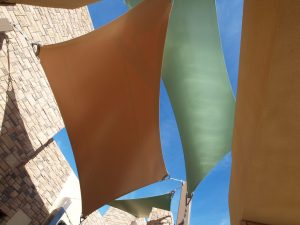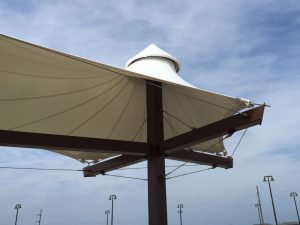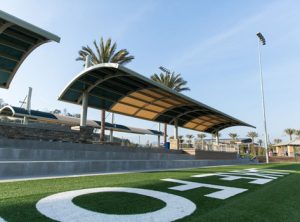Part 2 of 5: In this five-part series, we provide an introduction to the world of tensile fabric architecture, including the history, current applications, engineering concepts, modern materials, and the innovative benefits. Click here to read additional posts.
 Tensile fabric architecture (aka tension structures or tensioned membrane structures) is an innovative form of construction characterized by structural forms that are created from the tensioning of otherwise flexible membrane materials, such as PVC Membranes or PTFE-Coated Fiberglass. The resulting structures are generally permanent or semi-permanent and can range from uniquely iconic to purely functional.
Tensile fabric architecture (aka tension structures or tensioned membrane structures) is an innovative form of construction characterized by structural forms that are created from the tensioning of otherwise flexible membrane materials, such as PVC Membranes or PTFE-Coated Fiberglass. The resulting structures are generally permanent or semi-permanent and can range from uniquely iconic to purely functional.
Generally speaking, tensile fabric architecture refers to either tensioned structures, which use cables and supports to create tension, or pneumatic structures, which instead use air pressure to create the tension. In this series, we’ll be exploring tensioned structures, as opposed to pneumatic structures.
Why Tensioning?
 In traditional architecture, ceilings and rooftops require beams, columns, and other support systems to be structurally sound. One of the greatest benefits of tensile fabric architecture is its ability to span long distances with minimal structural support from steel members and foundations. It enables architects to cover large areas without creating obstacles or obstructions – ideal for sports arenas and entertainment venues (among the vast range of other applications).
In traditional architecture, ceilings and rooftops require beams, columns, and other support systems to be structurally sound. One of the greatest benefits of tensile fabric architecture is its ability to span long distances with minimal structural support from steel members and foundations. It enables architects to cover large areas without creating obstacles or obstructions – ideal for sports arenas and entertainment venues (among the vast range of other applications).
Despite being incredibly durable, fabric membranes are rather flexible on their own. It’s the tensioning process that creates the necessary rigidity for the membrane to transform from a pliable material into a structural canopy or roof system. To better understand the concept, imagine a dismantled trampoline. Without the springs and framework, the woven fabric has little structural integrity. However, when assembled, that same fabric is pulled equally from each direction and becomes stable enough to support (and bounce) hundreds of pounds of weight.
What are the Tensioning Designs?
 There are many styles and shapes available to designers and engineers of tensile fabric architecture. All of the styles and shapes use strategically designed system of cables to create the necessary tension, so the membrane is able to remain stiff and structurally sound under all possible loads (such as wind loads and snow loads).
There are many styles and shapes available to designers and engineers of tensile fabric architecture. All of the styles and shapes use strategically designed system of cables to create the necessary tension, so the membrane is able to remain stiff and structurally sound under all possible loads (such as wind loads and snow loads).
Conical Designs feature one or multiple masts with a ring at the pinnacle that provides the center point of tension. These often resemble a tent, although there are many significant differences between a tent and a tension structure.
Hypar or Anticlastic Designs rely on two opposing curvatures to create tension and stability. These often resemble the shape of a saddle with two high points and two points.
Parallel Arch or Barrel Vault Designs use a variety of support systems and perimeter attachments to maintain the signature arch shape.
Cable Net & Membrane Designs leverage a cable grid to stretch the membrane over significant distances. These often are used for long-span roofing applications.
Is Tensile Fabric Architecture Right for Your Next Project?
In the Tension Structures Division of Eide Industries, we specialize in design, engineering, manufacturing, and installation of structurally complex and creatively challenging commercial, government, and prototype design projects. We provide expertise and support for architects, landscape designers, general contractors, and property owners to develop their custom tensile membrane project ideas and construct iconic structures.
Explore the options for your next project. Contact one of our experts today by calling 800-422-6827.
